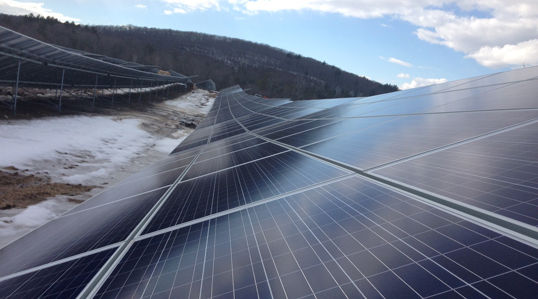
The 2.5-megawatt solar array in Palmer, pictured here, was developed by Major Energy and Greenhouse Solar.
As part of the institution’s commitment to sustainability and energy efficiency, UMass Medical School has reached a 30-year agreement to pay for up to 12 megawatts of solar-generated power from arrays being developed by First Wind, Major Energy, Greenhouse Solar and Hecate Solar in Massachusetts. The first of the three projects, a 2.5-megawatt facility in Palmer, started producing electricity in December. Over the course of agreement, UMMS is projected to save a third off its current energy costs—an equivalent of $715,000 annually at today’s rates.
“Stewardship of the environment is a core value set forth by UMass Medical School,” said Melissa Lucas, sustainability and energy manager at UMMS. “It takes strong partnerships to meet these challenges. By teaming up with First Wind, Major Energy, Greenhouse Solar and Hecate Solar, we are not only saving money, but we’re helping to make the electrical infrastructure we all use every day a little cleaner and more environmentally friendly.”
Under the Massachusetts public entity net metering program, UMMS is assigned the meters at the solar farms. As the power produced by the solar arrays is distributed to the electrical grid for use, the meters spin backwards. UMMS gets a credit in its monthly electric utility bill and pays the developers for the solar power at a reduced amount.
The Palmer array, developed by Major Energy and Greenhouse Solar, began producing power in December. The 24-acre solar farm features 8,620 solar panels spread over 772 strings and is capable of generating three million kilowatt hours a year—enough electricity to power 150 homes, according to Greenhouse Solar officials. This is the equivalent of reversing the carbon dioxide pollution effects of 225,000 gallons of automobile gasoline each year.
“It is a privilege to be kicking off our solar business in such a great market with such strong partners,” said Saul Horowitz, CEO of Major Energy. “Greenhouse Solar, The Massachusetts Department of Energy Resources and UMass Medical School have all done a great job at crafting a program that sets an excellent example for businesses and institutions in Massachusetts and throughout the country, on how to exercise fiscal diligence and environmental responsibility. Allowing customers to realize monetary savings while making a significant positive impact on the environment has always been one of our driving goals.”
A 6-megawatt solar farm in Warren being developed by First Wind is expected to begin generation in June. The UMMS portion of the project will contain 19,998 solar panels and will generate 7 million kilowatt hours of electricity per year. A typical fossil fuel burning energy plant generating equivalent electricity would emit more than 5,500 tons of carbon dioxide per year. By buying the power from the Warren solar project, UMMS is avoiding burning the equivalent of 13,000 barrels of oil or 3,700 tons of coal, and preventing more than 5,500 tons of carbon from entering the atmosphere.
“We’re pleased to help UMass Medical School take a major step toward reaching its renewable energy goals, while also helping it save on electricity costs,” said Carol Grant, senior vice president of external affairs at First Wind. “Forward-thinking institutions like UMMS recognize that renewable energy projects like ours in Warren deliver twin benefits of clean, emissions-free electricity and a good price.”
The final project, a 3.5-megawatt solar farm in Monson being developed by Hecate, is expected to go online in 2015.
“Because many of our buildings utilize mechanical systems designed for research use, there isn’t enough roof space to install solar panels,” said Lucas. “These types of net metering programs allow the medical school to tap into the benefits of solar power despite these challenges and further the commonwealth’s goal of increasing renewable energy in the state.”